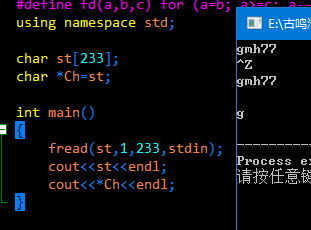C++fread/fwrite的基础用法
前言
fread是吼东西
应某人要求(大概)科普一下
fread
#include <iostream>
#include <cstdlib>
#include <cstring>
#include <cstdio>
#define fo(a,b,c) for (a=b; a<=c; a++)
#define fd(a,b,c) for (a=b; a>=c; a--)
using namespace std;
char st[233];
char *Ch=st;
int main()
{
fread(st,1,233,stdin);
cout<<st<<endl;
cout<<*Ch<<endl;
}
可以用文件输入,也可以直接输并在最后加Ctrl+Z

(下面的空行是因为读入了一个换行符)
fread基本格式:
fread(字符串,1,字符串大小,stdin);
*Ch一开始指向的是st[0],之后可以不断*++Ch来往后跳
快速读入
#include <iostream>
#include <cstdlib>
#include <cstring>
#include <cstdio>
#define fo(a,b,c) for (a=b; a<=c; a++)
#define fd(a,b,c) for (a=b; a>=c; a--)
using namespace std;
char st[233];
char *Ch=st;
int getint()
{
int x=0;
while (*Ch<'0' || *Ch>'9') *++Ch;
while (*Ch>='0' && *Ch<='9') x=x*10+(*Ch-'0'),*++Ch;
return x;
}
int main()
{
fread(st,1,233,stdin);
cout<<getint()<<endl;
}
fwrite
用处并不是很大
fwrite(字符串,1,字符串长度,stdout);
快速输出
把数字转成字符串再反过来加进去(要加上空格/换行符)
#include <iostream>
#include <cstdlib>
#include <cstring>
#include <cstdio>
#define fo(a,b,c) for (a=b; a<=c; a++)
#define fd(a,b,c) for (a=b; a>=c; a--)
using namespace std;
char st[233];
int Len;
void putint(int x)
{
int a[233];
int i,len=0;
if (!x) len=1;
while (x)
{
a[++len]=x%10;
x/=10;
}
fd(i,len,1)
st[++Len]=a[i]+'0';
st[++Len]=' ';
}
int main()
{
Len=-1;
putint(1);
putint(2);
putint(233);
fwrite(st,1,Len,stdout);
}
真正的fread/fwrite
其实上面的都是假的
但是上面的很好写
下面的不需要额外空间,但不能关文件
#include <bits/stdc++.h>
using namespace std;
namespace io
{
const int SIZE = 1 << 22 | 1;
char iBuf[SIZE], *iS, *iT, c;
char oBuf[SIZE], *oS = oBuf, *oT = oBuf + SIZE;
#define gc() (iS == iT ? iT = iBuf + fread(iS = iBuf, 1, SIZE, stdin), (iS == iT ? EOF : *iS++) : *iS++)
template<class I> void gi(I &x)
{
int f = 1;
for(c = gc(); c < '0' || c > '9'; c = gc())
if(c == '-') f = -1;
for(x = 0; c >= '0' && c <= '9'; c = gc())
x = (x << 3) + (x << 1) + (c & 15);
x *= f;
}
inline void flush()
{
fwrite(oBuf, 1, oS - oBuf, stdout);
oS = oBuf;
}
inline void putc(char x)
{
*oS++ = x;
if(oS == oT) flush();
}
template<class I> void print(I x)
{
if(x < 0) putc('-'), x = -x;
static char qu[55];
char *tmp = qu;
do *tmp++ = (x % 10) ^ '0'; while(x /= 10);
while(tmp-- != qu) putc(*tmp);
}
struct flusher{ ~flusher() { flush(); } }_;
}
using io :: gi;
using io :: putc;
using io :: print;
int main()
{
int x;
gi(x);
print(x);
putc('\n');
return 0;
}
C++fread/fwrite的基础用法的更多相关文章
- PropertyGrid控件由浅入深(二):基础用法
目录 PropertyGrid控件由浅入深(一):文章大纲 PropertyGrid控件由浅入深(二):基础用法 控件的外观构成 控件的外观构成如下图所示: PropertyGrid控件包含以下几个要 ...
- 那些年,坑死自己的事之fread/fwrite
今天继续看牛人做过的东西,这个小程序并不大,加上相当多的注释行,才5000多行.这个小程序是在linux下实现的,之前自己也一直用vi来看并加以更加详细的注释,但是效率实在太低.于是将其转移到wind ...
- logstash安装与基础用法
若是搭建elk,建议先安装好elasticsearch 来自官网,版本为2.3 wget -c https://download.elastic.co/logstash/logstash/packag ...
- elasticsearch安装与基础用法
来自官网,版本为2.3 注意elasticsearch依赖jdk,2.3依赖jdk7 下载rpm包并安装 wget -c https://download.elastic.co/elasticsear ...
- BigDecimal最基础用法
BigDecimal最基础用法 用字符串生成的BigDecimal是不会丢精度的. 简单除法. public class DemoBigDecimal { public static void mai ...
- linux缓冲的概念fopen /open,read/write和fread/fwrite区别
fopen /open区别 UNIX环境下的C 对二进制流文件的读写有两套班子:1) fopen,fread,fwrite ; 2) open, read, write这里简单的介绍一下他们的区别.1 ...
- Linux read/write fread/fwrite两者区别
Linux read/write fread/fwrite两者区别 1,fread是带缓冲的,read不带缓冲. 2,fopen是标准c里定义的,open是POSIX中定义的. 3,fread可以读一 ...
- Vue组件基础用法
前面的话 组件(Component)是Vue.js最强大的功能之一.组件可以扩展HTML元素,封装可重用的代码.根据项目需求,抽象出一些组件,每个组件里包含了展现.功能和样式.每个页面,根据自己所需, ...
- Smarty基础用法
一.Smarty基础用法: 1.基础用法如下 include './smarty/Smarty.class.php';//引入smarty类 $smarty = new Smarty();//实例化s ...
随机推荐
- oracle ogg 单实例双向-新增表,修改表结构(oracle-oracle
--新增inset测试--dept 表结构orcl,ogg都存在,数据相同(但是rep1配置文件没有添加) SCOTT@ orcl ,'hongquan','BBA'); row created. S ...
- HDU4372(第一类斯特林数)
题意:N座高楼,高度均不同且为1~N中的数,从前向后看能看到F个,从后向前看能看到B个,问有多少种可能的排列数. 0 < N, F, B <= 2000 首先我们知道一个结论:n的环排列的 ...
- 【Linux开发】直接渲染管理
原文地址:https://dri.freedesktop.org/wiki/DRM/ DRM - Direct Rendering Manager DRM是一个内核级的设备驱动,既可以编译到内核中也可 ...
- 【Python基础】_2 Python基本语法与常识(迭代优化中...)
2 Python的基本语法 为了保证Python解释器能顺利编译所编写的代码,也为了程序员对自己和别人所编写的程序易于阅读.维护,对编程语言的语法做一些基本约定是非常必要的. 2.1 编程方式 2.1 ...
- 红帽学习笔记[RHCSA] 第二课[文件、目录、相关命令]
第二课 常用的目录结构与用途 / 根目录 /boot 存储的是系统起动时的信息和内核等 /dev 存储的是设备文件 /etc 存储的是系统的配置文件 /root 存储的是root用户的家目录 /hom ...
- 网站私有CA证书制作
所谓的网站安全证书 是通过在客户端浏览器和Web服务器之间建立一条SSL安全通道保证了双方传递信息的安全性,而且用户可以通过服务器证书验证他所访问的网站是否真实可靠. 大体步骤: ...
- 万万没想到,Spring Boot 竟然这么耗内存!
Spring Boot总体来说,搭建还是比较容易的,特别是Spring Cloud全家桶,简称亲民微服务. 但在发展趋势中,容器化技术已经成熟,面对巨耗内存的Spring Boot,小公司表示用不起. ...
- faker数据填充详解
安装 在laravel中已经自动集成,无需手动安装.如需在其他地方使用,可使用以下命令进行安装. composer require fzaninotto/faker 为Faker指定中文支持 可通过在 ...
- FFmpeg SDK开发模型之中的一个:解码器
简单介绍 本例解说了怎样使用ffmpeg SDK解码媒体文件: 參考源代码是ffmpeg 自带的apiexample.c 一.源代码#include <stdlib.h>#include ...
- Laravel 学习笔记之文件上传
自定义添加磁盘——upload 位置:config/filesystems.php 'disks' => [ 'local' => [ 'driver' => 'local', 'r ...
